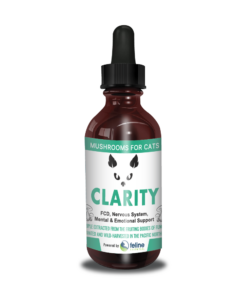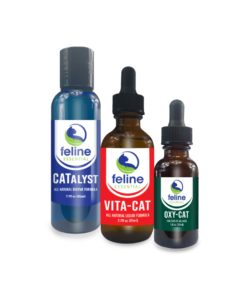When flea season rolls around, it makes sense to reach for flea medications for cats without hesitation. They’re recommended by vets, widely advertised, and easy to administer. But are these treatments right for your cat? Are they as safe as they seem?
We sat down with holistic veterinarian Dr. Katie Woodley, DVM (aka The Natural Pet Doctor), to discuss this hot topic on our podacst. We have so many cat parents reach out about flea treatments they’ve used – completely unaware of the side-effects they can cause. So, it’s time to uncover the real risks behind conventional flea medications for cats – and what safer, natural alternatives exist.
Why Flea Medications for Cats Are a Concern
Many popular flea treatments – like Bravecto, Revolution, Frontline, and Advantage – are insecticides, not repellents. This means the parasite must bite your cat before the medication works. And because these are chemical neurotoxins, they don’t just affect the flea – they can also impact your cat’s nervous system.
The isoxazoline class of flea medications (which includes Bravecto, NexGard, Credelio, and Simparica) has been linked to serious side effects. The FDA even issued a warning in 2018 after receiving thousands of reports of adverse reactions – including seizures, tremors, vomiting, liver failure, and even death.
Even worse, these drugs can stay in your cat’s body for more than 100 days. If you’re giving them monthly as prescribed, it creates a buildup that raises the risk of side effects with each dose.
Common Side Effects of Flea Medications for Cats
Some of the most reported reactions include:
-
Vomiting, diarrhea, and lethargy
-
Seizures or muscle tremors
-
Loss of coordination and behavioral changes
-
Hair loss or chemical burns at the application site
-
Excessive grooming, skin irritation, and drooling
Even topicals that seem “safer” can cause chemical burns and skin issues – and many people forget that other cats in the home can lick the treatment site during grooming.
Environmental Harm Is Real
Flea medications for cats don’t just affect your pet – they’re harmful to the environment too. These chemicals have been detected in waterways, bird nests, and soil. Studies show that a single topical application can kill tens of thousands of bees.
If you’re cuddling a treated cat, you’re also absorbing these toxins. And if you have children, the risk of chemical exposure increases even more.
Should You Use Flea Medications for Indoor Cats?
That monthly reminder to apply flea meds might not be necessary – especially for indoor-only cats or in regions with minimal flea and tick activity. Dr. Woodley explains, “I live in Colorado and don’t use any flea treatments in the winter – fleas aren’t around. There’s no reason to apply these every month year-round.”
Before reaching for conventional flea medications for cats, consider your environment, your cat’s exposure, and whether treatment is even needed.
Safer, Natural Alternatives to Flea Medications
Dr. Woodley recommends a layered approach using natural, non-toxic options to protect cats from fleas and ticks safely.
1. External Repellents
-
Flea-eX – A safe, plant-based spray that can be used on cats, bedding, and carpets. (Yes, you can spray it in your mouth—it’s that safe. It’s just not delicious.)
-
Flea combs – Use daily to check for fleas, especially if your cat goes outside.
-
Essential oil sprays – Only use formulas specifically made for cats, like those from AnimalEO or Kin + Kind.
2. Internal Support
-
Herbal supplements like Wildly Blended Bug Off use natural flea-repelling herbs like neem, nettle, and holy basil to make your cat less attractive to pests.
3. Environmental Control
-
Diatomaceous Earth – Kills flea larvae in carpets and rugs (avoid inhalation).
-
Beneficial nematodes – Kill fleas in your yard.
-
Flea-repelling plants – Mint, rosemary, and marigolds help keep your outdoor space pest-free.
4. Innovative Options
-
Fleas Gone Tag – Worn on a collar, this tag creates a bio-shield that repels pests. A University of Madrid study showed reduced fleas and ticks after 28 days with no adverse effects.
What About Flea Allergy Dermatitis?
If your cat is allergic to flea bites (known as flea allergy dermatitis), conventional flea medications won’t help – because the flea still has to bite. Instead, repellents are the best option to prevent the bite altogether. Addressing your cat’s immune health is also key, as weakened immunity increases their sensitivity to bites.
If You Must Use a Medication…
Dr. Woodley notes that if natural remedies aren’t working and you’re facing a serious infestation, Capstar is the least toxic conventional option. It’s fast-acting and doesn’t stay in the body for months like others in the isoxazoline class. However, it’s not a long-term solution – so focus on addressing the root causes and environmental control.
The Bottom Line
Flea medications for cats are not one-size-fits-all. While they may seem convenient, they come with serious risks – to your cat’s health, your household, and the planet.
By choosing safer, natural alternatives and understanding when treatment is actually necessary, you can protect your cat without compromising their wellbeing. As Dr. Woodley reminds us, “When you know better, you do better.”
Want to learn more from Dr. Woodley?
Visit thenaturalpetdoctor.com for holistic guidance, resources, and her Better Gut Health Blueprint program.
And if you’re looking for a safe, effective natural flea treatment, check out Flea-eX – trusted by us and our community of cat lovers across the country.




Recent Comments